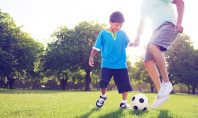Get Back on the Field Faster

How to treat (and prevent)school sports injuries
Despite our best efforts – good coaching, practice, protective gear – it’s practically a given that sooner or later someone’s going to get hurt on the playing field. Thankfully, the days of “Walk it off!” are long gone, and we now understand the importance of properly treating sports injuries.
According to Timothy W. Miller, DPT, regional director of physical therapy for St. Luke’s University Health Network, many common injuries in young players include foot and ankle sprains, muscle strains, tendon injuries, and stress fractures. And while they may seem relatively minor, ignoring them can lead to more trouble down the line.
“If you skip treatment, or stop it too soon, you can easily re-injure yourself,” Dr. Miller says. And simply trying to play again when you’re not completely healed will hamper performance. Fortunately, the physical therapy program at St. Luke’s can help young athletes heal better and help them return to the field or court faster.
“We have direct access to all the specialties in the St. Luke’s network,” Dr. Miller explains. “When you come in for an evaluation, we can start your physical therapy program right away – you won’t need to see a physician first. But if we determine that PT really isn’t appropriate in a given case, we can refer that patient quickly to one of our orthopedic surgeons or other specialists.”
The first step in a PT program is to evaluate pain, swelling, and range-of-motion. That info helps the therapist design a program geared to those particular symptoms. Stretches and other exercises address basic strengthening of damaged areas, as well as improving functional, day-to-day activities. “But we also concentrate on exercises important for particular sports,” says Dr. Miller. “For example, a rehab program for a basketball player would include a focus on better running and jumping. We’d also show them how to correct imbalances and improper technique, and how to lessen the potential for future injury.”
Sticking with one activity means you’ll be working (and perhaps overworking) a certain group of muscles, sometimes at the expense of others, and that can increase the likelihood of injury.
To help prevent injuries in the first place, Dr. Miller suggests that kids play more than one sport when possible, even if they have their heart set on being a football or baseball standout: “In this year’s NFL draft, 29 of the 32 first-round draft picks were multi-sport athletes in high school.”
For more information on physical therapy and sports rehabilitation, visit stlukesphysicaltherapy.com/specialties/physical-therapy/sports-rehabilitation





















